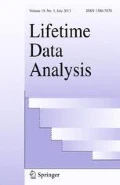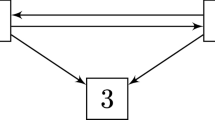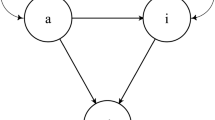Abstract
In non-Markov multi-state models, the traditional Aalen–Johansen (AJ) estimator for state transition probabilities is generally not valid. An alternative, suggested by Putter and Spitioni, is to analyse a subsample of the full data, consisting of the individuals present in a specific state at a given landmark time-point. The AJ estimator of occupation probabilities is then applied to the landmark subsample. Exploiting the result by Datta and Satten, that the AJ estimator is consistent for state occupation probabilities even in non-Markov models given that censoring is independent of state occupancy and times of transition between states, the landmark Aalen–Johansen (LMAJ) estimator provides consistent estimates of transition probabilities. So far, this approach has only been studied for non-parametric estimation without covariates. In this paper, we show how semi-parametric regression models and inverse probability weights can be used in combination with the LMAJ estimator to perform covariate adjusted analyses. The methods are illustrated by a simulation study and an application to population-wide registry data on work, education and health-related absence in Norway. Results using the traditional AJ estimator and the LMAJ estimator are compared, and show large differences in estimated transition probabilities for highly non-Markov multi-state models.









Similar content being viewed by others
References
Aalen OO, Borgan Ø, Fekjær H (2001) Covariate adjustment of event histories estimated from Markov chains: the additive approach. Biometrics 57(4):993–1001
Aalen OO, Borgan Ø, Gjessing H (2008) Survival and event history analysis: a process point of view. Springer, New York
Allignol A, Beyersmann J, Gerds T, Latouche A (2014) A competing risks approach for nonparametric estimation of transition probabilities in a non-Markov illness-death model. Lifetime Data Anal 20(4):495–513
Andersen PK, Keiding N (2002) Multi-state models for event history analysis. Stat Methods Med Res 11(2):91–115
Andersen PK, Pohar Perme M (2008) Inference for outcome probabilities in multi-state models. Lifetime Data Anal 14(4):405–431
Andersen PK, Pohar Perme M (2013) Multistate models. In: Klein JP, van Houwelingen HC, Ibrahim JG, Scheike TH (eds) Handbook of survival analysis. Chapman & Hall/CRC, Boca Raton, pp 417–439
Andersen PK, Borgan Ø, Gill RD, Keiding N (1993) Statistical models based on counting processes. Springer, New York
Bender R, Augustin T, Blettner M (2005) Generating survival times to simulate Cox proportional hazards models. Stat Med 24(11):1713–1723
Breslow NE (1972) Discussion of Professor Cox’s paper. J R Stat Soc Ser B 34:216–217
Cole SR, Hernán MA, Anastos K, Jamieson BD, Robins JM (2007) Determining the effect of highly active antiretroviral therapy on changes in human immunodeficiency virus type 1 RNA viral load using a marginal structural left-censored mean model. Am J Epidemiol 166(2):219–227
Datta S, Satten GA (2001) Validity of the Aalen-Johansen estimators of stage occupation probabilities and Nelson–Aalen estimators of integrated transition hazards for non-Markov models. Stat Probab Lett 55(4):403–411
Datta S, Satten GA (2002) Estimation of integrated transition hazards and stage occupation probabilities for non-Markov systems under dependent censoring. Biometrics 58(4):792–802
de Uña-Álvarez J, Meira-Machado L (2015) Nonparametric estimation of transition probabilities in the non-Markov illness-death model: a comparative study. Biometrics 71(2):364–375
de Wreede LC, Fiocco M, Putter H (2011) mstate: an R package for the analysis of competing risks and multi-state models. J Stat Softw 38(7):1–30
Glidden DV (2002) Robust inference for event probabilities with non-Markov event data. Biometrics 58(2):361–368
Gran JM, Wasmuth L, Amundsen EJ, Lindqvist BH, Aalen OO (2008) Growth rates in epidemic models: application to a model for HIV/AIDS progression. Stat Med 27(23):4817–4834
Gran JM, Lie SA, Øyeflaten I, Borgan Ø, Aalen OO (2015) Causal inference in multi-state models-sickness absence and work for 1145 participants after work rehabilitation. BMC Public Health 15(1):1082
Hernan M, Robins JM (2018) Causal inference. Chapman & Hall/CRC, Boca Raton
Hoff R, Corbett K, Mehlum IS, Mohn FA, Kristensen P, Hanvold TN, Gran JM (2018) The impact of completing upper secondary education - a multi-state model for work, education and health in young men. BMC Public Health 18(1):556
Hougaard P (1999) Multi-state models: a review. Lifetime Data Anal 5(3):239–264
Keiding N, Klein JP, Horowitz MM (2001) Multi-state models and outcome prediction in bone marrow transplantation. Stat Med 20(12):1871–1885
Lin DY, Wei LJ (1989) The robust inference for the Cox proportional hazards model. J Am Stat Assoc 84(408):1074–1078
Meira-Machado LF, de Uña-Álvarez J, Cadarso-Suárez C, Andersen PK (2008) Multi-state models for the analysis of time-to-event data. Stat Methods Med Res 18(2):195–222
Putter H, Spitoni C (2018) Non-parametric estimation of transition probabilities in non-Markov multi-state models: the landmark Aalen–Johansen estimator. Stat Methods Med Res 27(7):2081–2092
Putter H, Fiocco M, Geskus RB (2007) Tutorial in biostatistics: competing risks and multi-state models. Stat Med 26(11):2389–2430
Robins JM, Hernan MA, Brumback B (2000) Marginal structural models and causal inference in epidemiology. Epidemiology 11(5):550–560
Rosenbaum PR (1987) Model-based direct adjustment. J Am Stat Assoc 82(398):387–394
Røysland K (2011) A martingale approach to continuous-time marginal structural models. Bernoulli 17(3):895–915
Scheike TH (2002) The additive nonparametric and semiparametric Aalen model as the rate function for a counting process. Lifetime Data Anal 8(3):247–262
Sundet JM, Barlaug DG, Torjussen TM (2004) The end of the Flynn effect? A study of secular trends in mean intelligence test scores of Norwegian conscripts during half a century. Intelligence 32(4):349–362
Titman AC (2015) Transition probability estimates for non-Markov multi-state models. Biometrics 71(4):1034–1041
Wechsler D (1955) Manual for the Wechsler adult intelligence scale. Psychological Corp., Oxford, England
Acknowledgements
This work was financially supported by the Research Council of Norway (Grant Nos. 237831, 218368 and 273674).
Author information
Authors and Affiliations
Corresponding author
Additional information
Publisher's Note
Springer Nature remains neutral with regard to jurisdictional claims in published maps and institutional affiliations.
Electronic supplementary material
Below is the link to the electronic supplementary material.
Rights and permissions
About this article
Cite this article
Hoff, R., Putter, H., Mehlum, I.S. et al. Landmark estimation of transition probabilities in non-Markov multi-state models with covariates. Lifetime Data Anal 25, 660–680 (2019). https://doi.org/10.1007/s10985-019-09474-0
Received:
Accepted:
Published:
Issue Date:
DOI: https://doi.org/10.1007/s10985-019-09474-0




